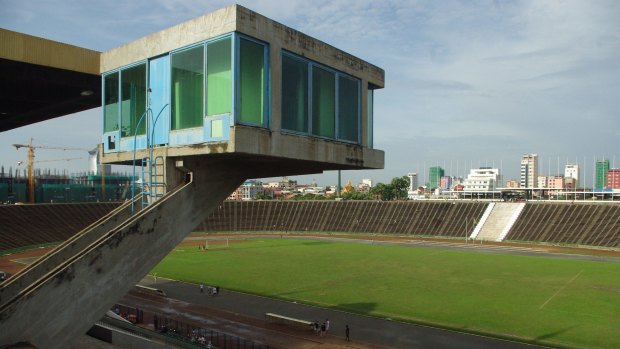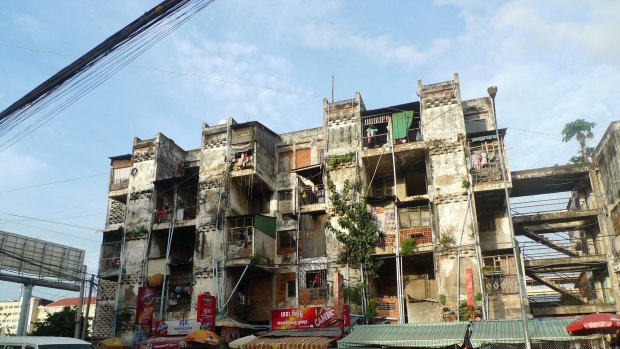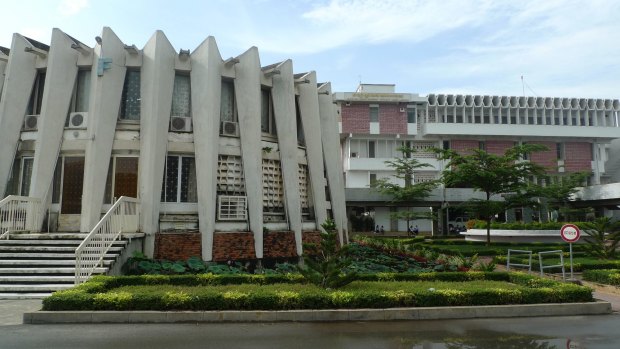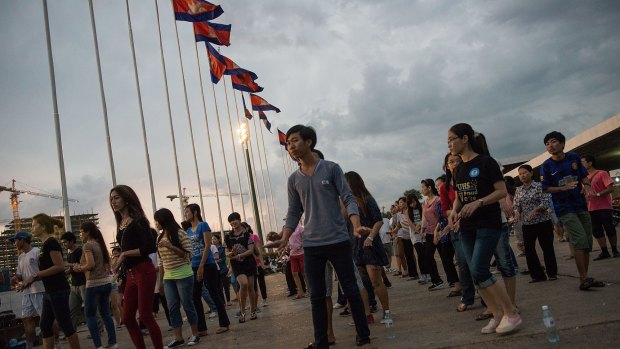By Andrea Black

Phnom Penh's Olympic stadium by architect Vann Molyvann.Credit: Andrea Black
It's sunset at Phnom Penh's Olympic Stadium. Across the top ring of concrete seating hundreds of Cambodians – mostly women over 55 – are doing the mashed potato in front of several sound systems. Next is a gangnam-style move. Beside the throng, sugar-cane juice stalls and makeshift beer stands sell refreshments. Here, open-air aerobic dance classes happen at dawn and dusk every day. Down by the pool there are yoga classes, kids are jumping off the diving boards and on the field local teams are playing soccer. But I'm not here to watch sport and recreation, I'm busy admiring the architecture. In the undercover area where a volleyball game is taking place, we walk in the extreme humidity to the very top. Our guide, a final-year architecture student, Virak Roeun, asks us to take a seat.
"Feel that breeze?" he says.
He points to architect Vann Molyvann's suspended zig-zag roof lines enabling air and light to filter in freely through the vented walls. There is a moat of cooling pools and streams along the walkways, an imitation of the moats surrounding Angkor Wat.

Architect Vann Molyvann's White Building apartment block. Photo: Andrea BlackCredit: Andrea Black
Indeed, the temples of Angkor Wat are not the only incredible structures worth seeking out on a trip to Cambodia. I'm on a 1960s New Khmer architecture tour with run by small association that began 12 years ago by British architect Geoff Pyle.
After gaining independence from France in 1953, Cambodia, for a period, experienced a cultural renewal. New creative movements emerged in art, film, dance and design. It was a time of optimism and experimentation. Musicians such as Sinn Sisamouth made the 60's swing. The Royal Ballet sent people into the forests to record traditional folk dances to incorporate them into modern dance. At the centre of this progressive time was a building boom out of which "New Khmer Architecture" emerged, with Cambodian-born architect Vann Molyvann, who studied at the Ecole Des Beaux Arts, leading the way. His structures, including the Olympic Stadium built in 1963 for the cancelled Games of the New Emerging Forces reinterpreted European modernism mixed with Khmer elements, incorporating local tradition, materials and taking the climate in account.
But the movement was short-lived after the Khmer Rouge forcibly depopulated the capital city, with residents fleeing to the countryside. It's estimated 90 per cent of Cambodia's artists died under Pol Pot's genocidal regime. Sisamouth was executed. Molyvann spent 20 years exiled in Europe.

Royal University of Phnom Penh Institute for Foreign Languages Library by architect Vann Molyvann. Credit: Andrea Black
Virak has already taken us by tuk-tuk to Molyvann's 100 Houses project, a stilted social housing development commissioned in 1965 by the National Bank of Cambodia for its staff. We find out that Vann Molyvann oriented his buildings north to avoid direct sunlight and buildings were raised off the ground as Phnom Penh is prone to monsoonal floodings. But his incredible designs incorporating cross ventilation green technologies, indirect lighting and evaporative cooling are not favoured by today's developers. Recently the land where the watered moat was around the Olympic Stadium was sold off to make way for poorly planned high-rise towers.
"Looking at the buildings that are being built today, I can tell that there is not much appreciation of Vann Molyvann's work," says Virak pointing at the cranes. Without the catchments the area now floods.
More examples of his design are on the Royal University of Phnom Penh grounds amongst the Spanish moss and roaming roosters. Molyvann's structures are breathtaking, and appear ahead of their time even now, 50 years later. Open-air walkways and gathering areas under the building shade the students from the heat. In the lecture halls of the Institute for Foreign Languages, breeze blocks allow the cooling winds to waft. The library is a circular building sitting on a pond with concrete columns descending like spiders' legs.

Crowds gather for a public dance class at the Olympic StadiumCredit: Getty Images/Luc Forsyth
"Molyvann based that design on a traditional Khmer straw hat," says Virak.
Our tour ends at the four-storey White Building on the banks of the Bassac River –it's like a mini Unité d'Habitation by Le Corbusier with public spaces and recreational areas on the rooftop. It was Le Corbusier who famously said that houses are machines for living in. Overseen by Molyvann, and built in 1963, the apartments were the first attempt to offer a modern urban lifestyle to lower-and middle-class Cambodians. 2500 residents call this home. It's in an extreme state of decay, people are living in the corridors and now, developers are threatening to destroy the building.
"When the main reinforced concrete structure is in danger to be ruined, some people would have reason to tear it down," says Virak.
He and the rest of the Khmer Architecture Tour team are working to get these buildings recognised and appreciated not just by tourists but locals as well, to help save them before developers turn them to rubble.
We walk up the steps to the roof to survey the Phnom Penh skyline and find we are part of a children's soccer game, a nightly occurrence up here.
"I love the fact that he designed a building for the people, he wasn't trying to show off his ideas as an architect," says Virak.
The writer travelled as a guest of Cruiseco.
TRIP NOTES
MORE INFORMATION
GETTING THERE
Singapore Airlines fly from Sydney and Melbourne to Singapore and then on to Ho Chi Minh City or Siem Reap. Phone 13 10 11, see singaporeairlines.com.au
CRUISING THERE
The Cruiseco Adventurer has 11-night packages from Siem Reap to Saigon or vice versa. Visit cruising.com.au or call (02) 9492 8520 for further information.
VISITING THERE
Khmer Architecture Tours New Khmer Architecture of the 1960s group tours are held on certain days throughout the year for 15 USD per person. You can also book a private custom tour by tuk-tuk, car or mini-bus. See ka-tours.org
Sign up for the Traveller Deals newsletter
Get exclusive travel deals delivered straight to your inbox. Sign up now.